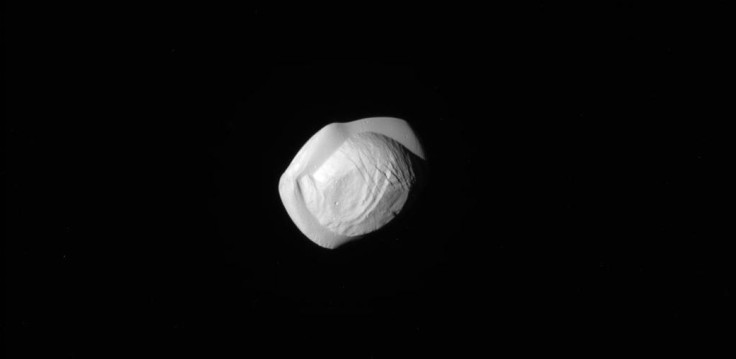Pan, Saturn’s Moon, Shows Its Bizarre Shape In Cassini Photograph

When we think of objects in space, at least the larger ones like stars, planets and moons, we think well-rounded shapes, which are caused by the effect of gravity in objects with large masses. And while comets and asteroids often have unusual shapes, a ravioli-shaped moon is something quite extraordinary.
But that’s quite close to what Pan, one of Saturn’s 62 known moons, looks like. It could also be seen as a walnut, albeit a flat-ish one, if that’s what you prefer. Actually, it could also be said to resemble the shape of a UFO, as it exists in popular imagination (not that we actually know what UFOs look like). The unusual shape of the celestial body was discovered by NASA’s Cassini spacecraft, which photographed the moon March 7.
Read: Cassini Snaps High-Res Pictures Of Saturn’s Pandora, Another Weird-Looking Moon

Pan is the second-innermost moon of Saturn, whose existence was first predicted in 1985 due to gravitational disturbances in the Encke Gap within Saturn’s A Ring — the outermost of the planet’s unique bright and large rings. It was photographed by Voyager 2, but its shape became clear only with the new photographs from Cassini.
The spacecraft made a flyby of Pan with a close-approach distance of 24,572 kilometers (15,268 miles). The center ridge on Pan is likely made up of ring material the moon has absorbed from the Encke Gap within which it orbits.
Read: Cassini Captures Details Pictures Of Saturn’s Rings
The Cassini-Hugyens mission is a collaboration between NASA, European Space Agency and the Italian Space Agency. It launched Oct. 15, 1997, and landed on Titan, Saturn’s largest moon, in January 2005. The imaging operations center for Cassini is at the Space Science Institute in Boulder, Colorado.
© Copyright IBTimes 2024. All rights reserved.





















